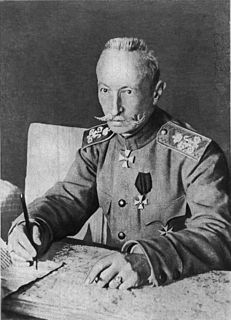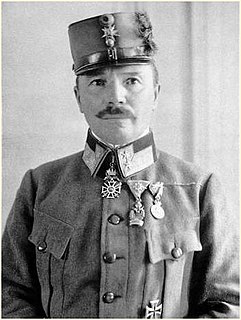Sources
This article includes a list of references, related reading or external links, but its sources remain unclear because it lacks inline citations .(January 2016) |
The Austro-Hungarian Eleventh Army was an Austro-Hungarian field army that fought during World War I.
The Eleventh Army was formed in March 1916 on the Italian Front, where it remained active until the end of the War.
It participated in the
This article includes a list of references, related reading or external links, but its sources remain unclear because it lacks inline citations .(January 2016) |

The Brusilov offensive, also known as the "June advance", of June to September 1916 was the Russian Empire's greatest feat of arms during World War I, and among the most lethal offensives in world history. The historian Graydon Tunstall called the Brusilov offensive the worst crisis of World War I for Austria-Hungary and the Triple Entente's greatest victory, but it came at a tremendous loss of life. The heavy casualties eliminated the offensive power of the Imperial Russian Army and contributed to Russia's collapse the next year.

Svetozar Boroević von Bojna was an Austro-Hungarian field marshal who was described as one of the finest defensive strategists of the First World War. He commanded Austro-Hungarian forces in the Isonzo front, for which he was nicknamed the "Lion of Isonzo".
The 1st Army was a field army-level command in the ground forces of Austria-Hungary during World War I. The army fought in Galicia and Russian Poland in 1914–15 before being briefly dissolved in the summer of 1916. Shortly afterwards, it was reformed and sent to fight in the Romanian Campaign for the next two years. The 1st Army was demobilized in April 1918 due to its heavy losses, following Romania's surrender.

The Italian front or Alpine front involved a series of battles at the border between Austria-Hungary and Italy, fought between 1915 and 1918 in the course of World War I. Following secret promises made by the Allies in the 1915 Treaty of London, Italy entered the war aiming to annex the Austrian Littoral, northern Dalmatia, and the territories of present-day Trentino and South Tyrol. Although Italy had hoped to gain the territories with a surprise offensive, the front soon bogged down into trench warfare, similar to that on the Western Front in France, but at high altitudes and with very cold winters. Being the largest and most lethal offensive during the WW1, the effects of the Russian Brusilov offensive were far reaching, it helped to relieve the German pressure on Battle of Verdun, also helped to relieve the Austro-Hungarian pressure on the Italians, as a result the Austro-Hungarian Armed forces were fatally weakened in such a degree that Austria-Hungary was unable to conduct a major military operation without German help, finally Romania decided to enter the war on the side of the Allied Forces, however the Russian human and material losses also greatly contributed to the Russian revolutions. Fighting along the front displaced much of the local population, and several thousand civilians died from malnutrition and illness in Italian and Austro-Hungarian refugee-camps. The Allied victory at Vittorio Veneto, the disintegration of the Habsburg empire, and the Italian capture of Trento and Trieste ended the military operations in November 1918. The armistice of Villa Giusti entered into force on 4 November 1918, while Austria-Hungary no longer existed as a unified entity. Italy also refers to the Great War as the Fourth Italian War of Independence, which completed the last stage of Italian unification.

The Sixth Battle of the Isonzo also known as the Battle of Gorizia was the most successful Italian offensive along the Soča (Isonzo) River during World War I.

Viktor Julius Ignaz Ferdinand Graf Dankl von Kraśnik was a highly decorated Austro-Hungarian officer who reached the pinnacle of his service during World War I with promotion to the rare rank of Colonel General (Generaloberst). His successful career met an abrupt end in 1916 due to both his performance on the Italian front and health issues. After the war, he would be a vocal apologist for both his country's war record and the dethroned Habsburg monarchy.

The Military Order of Maria Theresa was the highest military honour of the Habsburg monarchy, Austrian Empire and Austro-Hungarian Empire.

The Second Battle of the Isonzo was fought between the armies of the Kingdom of Italy and of Austria-Hungary in the Italian Front in World War I, between 18 July and 3 August 1915.

This article is about Italian military operations in World War I.

Viktor Graf von Scheuchenstuel was a colonel general in the Austro-Hungarian Army. He was a general staff officer and division commander until World War I broke out. During World War I he was a Corps and Army commander serving in Serbia, Albania and Italy. During World War I he was promoted to Graf in the Austrian nobility. Following the end of World War I and the end of the Austro-Hungarian Empire, Scheuchenstuel retired from the military. He died in Vienna.

The Seventh Battle of the Isonzo was fought from September 14–17, 1916 between the armies of the Kingdom of Italy and those of Austria-Hungary. It followed the Italian successes during the Trentino Offensive and the Sixth Battle of the Isonzo in the spring of 1916.

The Battles of the Isonzo were a series of 12 battles between the Austro-Hungarian and Italian armies in World War I mostly on the territory of present-day Slovenia, and the remainder in Italy along the Isonzo River on the eastern sector of the Italian Front between June 1915 and November 1917.
The Toplica Uprising was a Serb rebellion in 1917 carried out by Serbian guerrillas (Chetniks) in the Toplica District against the Bulgarian occupation force in the eastern part of the Kingdom of Serbia, occupied since October 1915. The rebellion lasted from 21 February to 25 March 1917.

The leaders of the Central Powers of World War I were the political or military figures who commanded or supported the Central Powers during World War I.
The Austro-Hungarian Tenth Army was an Austro-Hungarian field army that fought during World War I.

The Austro-Hungarian Fourth Army was an Austro-Hungarian field army that fought during World War I.
The 3rd Army was a field army-level command within the ground forces of Austria-Hungary during World War I. It was primarily active on the Eastern Front against the Russian Empire and in the Balkans against Serbia and Montenegro. Later on, the 3rd Army took part in some fighting on the Italian Front before returning to the eastern theater by 1917 to repulse the Kerensky Offensive. Its remaining units were merged with the 7th Army in January 1918.
The South Tyrolean Army Group was an army group of the Austro-Hungarian Army, which operated in South Tyrol against Italy, between 1 March 1917 and the end of World War I. It was also called Army Group Conrad and Army Group Archduke Joseph after its commanders.

Karl Freiherr von Kirchbach auf Lauterbach, from 1917 Count von Kirchbach auf Lauterbach, was a colonel general of the Austro-Hungarian Army.

Ludwig Goiginger was an Austro-Hungarian Lieutenant Field Marshal who notably served in World War I.